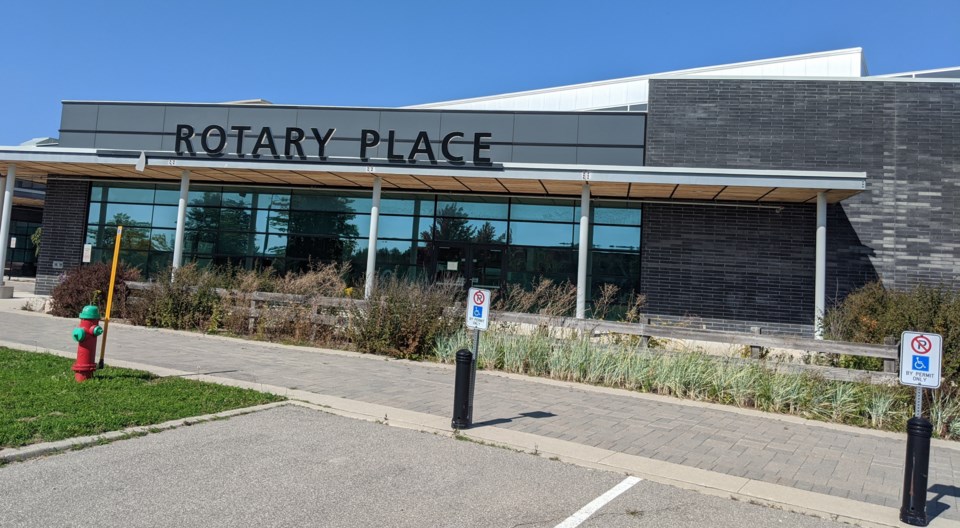On the heels of legionella outbreaks in Orillia and Barrie and amid concerns that “the burden” of the disease is “underestimated and rising in Ontario,” local health officials are calling on the province to step up regulations.
The board of health for the Simcoe Muskoka District Health Unit (SMDHU) is asking the province to mandate a registry of all cooling towers “as a first step toward improving the control of legionella in the province.”
In October 2019, an outbreak of the potentially fatal disease sparked a cluster of 10 confirmed cases of legionella in Orillia. An investigation determined a strain of legionella found in the Rotary Place cooling tower was a close match to two of the cluster's cases.
The cooling tower at Rotary Place — a municipal arena on University Avenue in Orillia — is part of the refrigeration system required to keep the ice surface in good condition.
Cooling towers are found in many places and are used to keep large spaces air-conditioned. As a result, when the outbreak happened, the health unit began looking at buildings that had cooling towers and initially thought the outbreak was tied to a large downtown Orillia building.
One of the challenges that arose is there is no registry of cooling towers. Health unit officials had to work with the city, the hospital, private-sector employers and other agencies to determine where cooling towers existed. It was an arduous process that delayed the ability to pinpoint the source of the outbreak, say officials.
“The lack of a provincial requirement for a cooling tower registry means public health units must deploy considerable time and resources to identify potential cooling tower sites, delaying public health action when clusters of cases of Legionnaires' disease require investigation,” notes the letter from the board of health that was recently circulated to municipal councils throughout Simcoe County.
The letter notes that legionella bacteria “are ubiquitous in freshwater environments and can replicate under favourable conditions in water distribution and plumbing systems, posing a risk to people. Cooling towers, notably, can cause significant community outbreaks of legionella infections via spread of contaminated water particles” over distances of several kilometres.
“To protect Ontarians from potentially fatal disease, strategies mitigating the risk of legionella spread from cooling towers are needed,” notes the letter from the health board to the province.
“Given operational considerations and the knowledge gaps that persist in the literature, the implementation of a province-wide mandatory cooling tower registry is recommended as a first step toward improving the control of legionella in the province,” noted the letter.
But it’s just one step. Local health officials are also asking the province to mandate a risk management plan for cooling towers to operate.
Basic elements of the risk management plan may include:
- Documented system maintenance requirements, including scheduled inspection;
- Specified routine water treatment protocols, including chemical treatment or other specialized treatment equipment. The goals of a water management plan are to extend equipment life, minimize energy consumption, minimize water consumption, and maintain a safe environment;
- System standby and shutdown protocols;
- Disinfection protocols to remedy deviations from expected standards on routine monitoring, including when disinfection is urgently required;
- Contingency response plan in the event of known or suspected cases of Legionellosis.
Orillia Mayor Steve Clarke applauds the initiative, referencing how frustrating it was trying to identify the source of the outbreak in Orillia.
“I am very glad to see the SMDHU take the lead in calling for a province-wide mandatory cooling tower registry,” said Clarke, who called it a “meaningful first step” that makes sense.
“A common registry would be of benefit in establishing a consistent province-wide operational standard for cooling towers to aid in prevention and also assist a health unit in post-incident investigations," he added.
Currently, the city of Hamilton is the only jurisdiction in the province that requires registration of all cooling towers with local authorities.
The health unit letter references statistics that show legionella infections are on the rise locally and across Ontario.
According to the letter, there were more than 300 cases of legionellosis reported in both 2018 and 2019 across the province, while previous years had an average of around 160 cases.
“These are the highest rates of legionellosis reported in Ontario in recent history,” notes the letter signed by Anita Dubeau, the deputy mayor of Penetanguishene and the chair of the board of health.
“Our experience in Simcoe-Muskoka mirrors the provincial trend,” notes the letter.
In 2019, Simcoe-Muskoka reported 20 cases, which is the most cases on record for the region in a single year. However, 2018 was also an "exceptionally high" year with 10 cases reported, and the five-year average for 2013-17 was 4.4 cases per year for Simcoe-Muskoka.
Fifteen of the cases reported in 2019 were tied to two clusters investigated by the local health unit in Orillia and Barrie.
“Both clusters were hypothesized to be caused by aerosolization of contaminated water particles originating from cooling towers (and) a cooling tower origin was confirmed for Orillia via genetic sequencing,” notes the letter.
A combined 67 sites were investigated for possible cooling tower presence across both municipalities.
“A province-wide cooling tower registry with required registration for all cooling tower owners and mandated implementation of a risk management plan for each cooling tower are first steps toward shifting away from a purely reactionary approach to the control of Legionella,” notes the letter.
“These two requirements can serve as necessary building blocks for control measures for cooling towers, which include routine environmental sampling, reporting, and auditing to further support a comprehensive risk management plan for cooling towers,” the letter concludes.
People can develop Legionnaires’ disease when they inhale aerosolized water droplets containing the bacteria. However, most people exposed to the bacteria do not become ill. People cannot get Legionnaires’ disease by drinking water and it cannot be passed from person to person.



